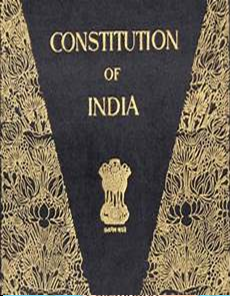A LIVING CONSTITUTIONAL MUSEUM
Syllabus:
- GS-2– Constitution of India -a living organic document , amendments in constitution
Focus :
- The article highlights the need for a Constitution Museum in India to commemorate the 75th anniversary of the Constitution’s adoption. It discusses the importance of such a museum in preserving the legacy of the Constitution, promoting civic education, democratizing access to constitutional knowledge, and fostering public discourse, thereby strengthening the democratic fabric of the country
Source-TH
Introduction:
- Adoption of the Constitution: On November 26, 1949, the Constituent Assembly of India
adopted the Constitution, which came into effect on January 26, 1950, celebrated as Republic Day.
- 75th Anniversary Celebration: This year marks the 75th anniversary of the Constitution’s adoption, a milestone that prompts us to reflect on its significance and legacy.
- Constitution Day: In 2015, the Government of India declared November 26 as Constitution Day, previously celebrated as National Law Day, to honor the framers of the Constitution and highlight its enduring relevance.
The Constituent Assembly: Crafting a Visionary Document
Historical Context:
- First and Last Sessions: The Constituent Assembly held its first meeting on December 9, 1946, and its last session on January 24, 1950.
- Challenging Circumstances: The Assembly undertook the task of drafting the Constitution amid significant social, economic, and political upheavals in India.
Vision of the Framers:
- Beyond Legal Provisions: The framers viewed the Constitution not merely as a legal document but as a tool for social revolution.
- Granville Austin’s Observation: The Constitution was designed to usher in a social revolution, influencing the choice of parliamentary government, direct elections, Fundamental Rights, Directive Principles, and other provisions.
Constitution of India: A Living Dynamic Document
- Amendments and Judicial Interpretations: The Constitution has evolved through various amendments by Parliament and interpretations by the judiciary, making it one of the world’s most dynamic and adaptive constitutions.
- Inspiration for Future Generations: The 75-year journey of the Constitution is a testament to its ability to adapt to changing times while remaining committed to its foundational values.
The Case for a Constitution Museum
Objectives of a Constitution Museum
- Capturing History and Evolution: The museum should document not only the Constitution’s history but also its ongoing evolution, including amendments and landmark judicial interpretations.
- Promoting Civic Education: The museum should promote civic education, empowering citizens with knowledge of their rights, duties, and the principles of the Constitution.
- Understanding Constitutional Evolution: The museum should provide a comprehensive understanding of the Constitution’s evolution, its important provisions, and amendments.
- Promoting Responsible Citizenship: Enlightened citizens are crucial for the functioning of a democracy; thus, the museum should foster appreciation for constitutional principles and values.
Highlighting the Contributions of Framers:
- Recognizing the Framers’ Efforts: The museum should pay tribute to the framers of the Constitution, especially lesser-known figures, including the 15 exceptional women members.
- Celebrating S. Benegal Narsing Rau: Recognize the contribution of Benegal Rau, the Constitutional Advisor, who prepared the initial draft of the Constitution.
Promoting Civic Education and Engagement
- Educating Citizens: The museum should impart constitutional knowledge to people from all walks of life to enable them to become effective participants in Indian democracy.
- Empowering the Citizenry: Understanding the Constitution is the first step toward empowering citizens, as it outlines not only rights and freedoms but also mechanisms for seeking justice.
Encouraging Public Discourse:
- Fostering Vibrant Conversations: A Constitution Museum would facilitate wider discussions about democracy and the Constitution, contributing to stronger democratic politics in India.
- Connecting Past, Present, and Future: As real museums transform time into space, connecting historical contexts with contemporary challenges and future aspirations.
Role of a Constitution Museum in Promoting Democratic Values
- Safeguarding Rights and Freedoms:A museum dedicated to the Constitution would help young people engage with its values, safeguarding the future of the nation.
- Highlighting Constitutional Remedies: The museum should educate citizens about the Constitution’s provisions for protecting rights and seeking remedies when rights are threatened
- Legacy of Visionary Leaders: The museum would celebrate the values and ideals embedded in the Constitution, promoting responsible and enlightened citizenship.
- Thomas Jefferson’s View on Enlightened Citizenship: Emphasize that an enlightened citizenry is indispensable for a republic’s proper functioning, underscoring the importance of civic education.
Conclusion: A Museum for All Generations
- Empowering through Knowledge: A Constitution Museum would provide citizens with a deeper understanding of their rights and responsibilities, empowering them to participate more effectively in democracy.
- Preserving and Promoting Constitutional Values: The museum would play a vital role in preserving the values of justice, equality, and liberty enshrined in the Constitution.
- Fostering Informed Citizenship: The museum would encourage an informed and engaged citizenry, essential for the health of any democracy.
- Lasting Legacy: The establishment of a Constitution Museum would be a fitting tribute to India’s democratic journey and the enduring vision of its Constitution.
Mains UPSC Question
GS 2
Discuss the significance of establishing a Constitution Museum in India to commemorate the 75th anniversary of the Constitution’s adoption. How can such a museum contribute to the democratic fabric of the country?”Top of FormBottom of Form(250 words)




